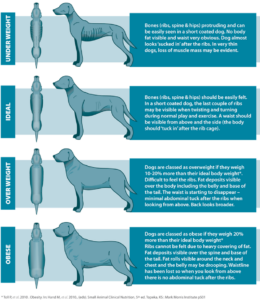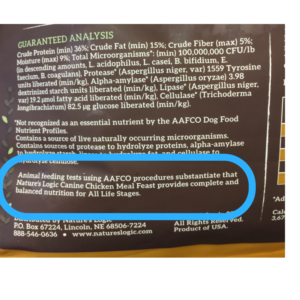An article from WWA’s Doctor’s Orders
 By Dr. K.C. Brooks, an avid waterfowler, dog lover and practicing veterinarian at Lodi Veterinary Care.
By Dr. K.C. Brooks, an avid waterfowler, dog lover and practicing veterinarian at Lodi Veterinary Care.
This article originally appeared in Wisconsin Waterfowl Association’s September, 2022 eNewsletter.
How you feed your retriever may be one of the most important issues related to their health and performance in the field. Unfortunately, canine nutrition is a very poorly understood topic and the dog food industry spends much more money on marketing than it does on real education of pet owners. This article is intended to provide some basic information on nutrition for your hunting dog.
 One of the most important principles in how you feed your dog is the concept of “feeding your dog to their body condition”. While I can give you some general guidelines on how much to feed, each dog is unique in their need for calories. Therefore, using the dog food bag’s guidelines for how much to feed will most often result in a very poor outcome. If you haven’t done so yet, I would strongly suggest working with your veterinarian to become familiar with a body condition scoring system so you can repeatedly assess your dog’s body condition throughout the year. Nothing is more important to the long-term health of your dog than avoiding obesity. Just as in humans, obesity is linked to a long list of serious health conditions and is the number one health issue in dogs. Keeping your dog at an ideal body condition throughout the year sets them up for success once they need to perform during the season.
One of the most important principles in how you feed your dog is the concept of “feeding your dog to their body condition”. While I can give you some general guidelines on how much to feed, each dog is unique in their need for calories. Therefore, using the dog food bag’s guidelines for how much to feed will most often result in a very poor outcome. If you haven’t done so yet, I would strongly suggest working with your veterinarian to become familiar with a body condition scoring system so you can repeatedly assess your dog’s body condition throughout the year. Nothing is more important to the long-term health of your dog than avoiding obesity. Just as in humans, obesity is linked to a long list of serious health conditions and is the number one health issue in dogs. Keeping your dog at an ideal body condition throughout the year sets them up for success once they need to perform during the season.
If you are wired to be more “scientific” about how much to feed your dog, you can calculate the calories they need based on their body weight. Of course, this still does not take into account all of the factors that lead to wide variations between dogs. In general, the maintenance calories for an average dog can be determined by taking the body weight of your dog in kilograms, raised to the ¾ power, then multiplying by 70. This will give you the number of kilocalories (kcals) your dog would need during periods of inactivity. Using this formula, the average 50-pound dog would need about 1,193 kcals per day as a baseline (50 lbs/2.2kg X 0.75) X 70). During periods of high demand, that number would be increased anywhere from 2-5 times depending on your dog’s metabolism, effort and weather conditions. Remember that performance in very cold weather (or water) can increase the demand for calories drastically.
One of the most common questions I get from dog owners is what brand of food should they feed and how much protein should be in that food. That question is almost impossible to answer in a very direct way for many reasons. Let’s start with the basics. Labeling pet food is a very inexact science. Manufacturers can play many games with an ingredients list which makes analyzing that list next to impossible. Furthermore, most labels list protein and fat in terms of “minimum contents”. That means that a food with a 30% protein content may really contain 40% protein. Importantly, it is the quality of the ingredients that most often determine whether a food is going to be good for your dog. The “quality” factor cannot be obtained from reading a label or talking to a salesperson at a pet food store. The market is flooded with dog foods that have spent their budget on marketing and packaging in hopes of garnering their share of a multi-billion-dollar industry.
 The second important concept in canine nutrition is to feed a brand of food with a proven track record of producing good food and that carries an AAFCO statement for the purpose it is labeled for. AAFCO (American Association of Feeding Control Officials) is the best indication that at least the food is formulated appropriately. Also, if you are investigating a pet food company, be sure they have a nutritionist on staff that is involved in the production of their foods.
The second important concept in canine nutrition is to feed a brand of food with a proven track record of producing good food and that carries an AAFCO statement for the purpose it is labeled for. AAFCO (American Association of Feeding Control Officials) is the best indication that at least the food is formulated appropriately. Also, if you are investigating a pet food company, be sure they have a nutritionist on staff that is involved in the production of their foods.
The protein question comes because many pet food manufacturers have convinced consumers that protein content is associated with food quality. In reality, that is false. High quality protein is important to a performance dog but excessive protein is of little value and can actually be harmful to older dogs and dogs with certain metabolic problems like kidney disease. Unlike humans, the fat content of dog food is the most important source of energy for endurance in a performance dog. Indeed, the main difference in a performance diet vs a maintenance diet is usually the fat content. In general, a fat content of 15-20% would be appropriate for a performance diet. While carbohydrates do play some role in providing fuel for short bursts of energy, they are not as critical as they are in humans. Quality, animal-based protein is important to maintain and repair muscle tissue and to replenish the metabolic system of performance but most performance diets have plenty of protein available for these needs. In my opinion, grain free diets have no real place in the dog food marketplace. Some of these diets have been linked to an increased risk of heart disease resulting in the death of dogs. Finally, if you are going to transition your hunting dog to a performance diet for the hunting season, this transition is best done 6-8 weeks prior to the start of the season. This allows your dog’s gut and metabolic systems to adjust appropriately.
Another common question is when to feed my dog during hunting sessions. There are many opinions regarding this question but in general it is best to stick to feeding two meals. I encourage owners to feed a small meal (about ¼ of their daily food) early in the day. Hopefully this meal is fed at least two hours prior to taking them into the field. The remaining food is then fed during the evening, preferably 1-2 hours after they have finished working. Adding water to the food may be helpful for a couple of reasons. First, added water is one way to ensure adequate hydration. Many dogs do not readily consume enough water during their hunting day. This is especially true in colder weather conditions. Adding water is one way to give them a boost in that area. Secondly, some dogs do not eat well after exercising hard. Adding water sometimes adds some palatability to their food. In any case, having plenty of clean, cold, fresh water is an important piece of the nutrition puzzle for the hunting dog.
Snacks and supplements are the last issues I will address in this article. Snacks for the average hunting dog will do little to improve their performance in the field that day. A few dogs that have a tendency to have low blood sugar levels, might benefit from small snacks throughout the day. For most dogs, the snacks are just a way for us to show our appreciation and a willingness to share! Supplements are, for the most part, a good way to spend money with very little return on your investment. If your dog is in good health and eating a high-quality diet, there is little or no need for a supplement. Adding a glucosamine and chondroitin supplement for joint support may be of some value for a performance dog and is highly unlikely to cause any harm.
While canine nutrition is a tricky and inexact science, adhering to the few basic principles outlined above should help your dog perform at an optimal level. Many veterinarians can be a good source of unbiased nutrition information and your dog’s preseason checkup is a great time to raise issues related to how you feed your companion. Enjoy your dog!








